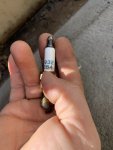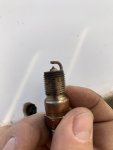Hey,
I'm new to the forum and a first-time owner to a 2003 Volvo-Penta 43. GL-C inboard outboard. It's in really good condition based on age. I've had an outboard Merc for years, so maintenance on this new engine is an adventure. I'd love for any tips.
Here is a list of the things we have done in the troubleshooting process with no real change.
- Changing of Distributor Cap (#3854331), rotor (OEM ROTOR 3854311), Spark plugs (AC41-993) and ignition wires (OEM 3888325).
- Cleaning out the Carborator
- Fiddling with idling control (which seemed to smooth it out a bit)
- Fiddling with timing light and shunt (Connector Tool 885163)
All of which have not made it run any smoother or worse, aside from the changing of ideal speed.
The timing line was about a 1/4 - 1/2 inch from the notch in the block but when we used the shunt connector, it got even rougher.
The compression of all cylinders are high (over 120 if I recall, but I would be wrong) and equal across the board.
My father and I would love to get to know the engine better before we send it into the shop.
Does anyone have some advice on what to check next?
I'm new to the forum and a first-time owner to a 2003 Volvo-Penta 43. GL-C inboard outboard. It's in really good condition based on age. I've had an outboard Merc for years, so maintenance on this new engine is an adventure. I'd love for any tips.
Here is a list of the things we have done in the troubleshooting process with no real change.
- Changing of Distributor Cap (#3854331), rotor (OEM ROTOR 3854311), Spark plugs (AC41-993) and ignition wires (OEM 3888325).
- Cleaning out the Carborator
- Fiddling with idling control (which seemed to smooth it out a bit)
- Fiddling with timing light and shunt (Connector Tool 885163)
All of which have not made it run any smoother or worse, aside from the changing of ideal speed.
The timing line was about a 1/4 - 1/2 inch from the notch in the block but when we used the shunt connector, it got even rougher.
The compression of all cylinders are high (over 120 if I recall, but I would be wrong) and equal across the board.
My father and I would love to get to know the engine better before we send it into the shop.
Does anyone have some advice on what to check next?






















